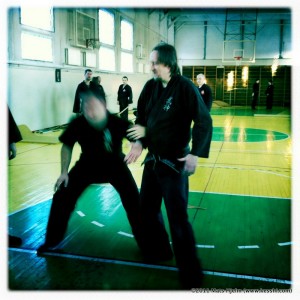From Shiro Kuma's Weblog by kumablog

Saino Tamashii Utsuwa
In the year 2009 the theme was 才能 魂 器 ”saino konki” or “saino tamashii utsuwa”. It just occurred to me today that this sanshin is in fact the essence of the tenchijin. The true Sanshin!
These three words can have the following meanings: ability, soul, container. If we understand easily the meanings of ability and soul, the container, until today, was limited for me to the space in which the encounter is taking place.
But what if in fact if this utsuwa is also defining the body. I think that both (space and body) are correct, but here I want to dwell a little more on this new understanding of the body being the container.
When we study the martial arts, we often come down to the sentence “body and mind are one”. If we assume that this “body/mind” which is not duality but unity, is in fact the expression of a superior inyo (yinyang); then this inyo can be the “ten” and the “chi”. And therefore it is quite logical to see 才能 saino (ability) as “jin”, making the saino konki the Sanshin of tenchijin. Strangely (or not) this is the theme sensei had chosen when he asked the high ranks to teach again the tenchijin to the new generations of bujinkan students.
In the “demon’s sermon on the martial arts”, Issai Chozanshi writes: “there is no form to principle, and principle’s function manifests itself according to the vessel. If there is no vessel, you will not see the principle.” Sensei has been teaching natural movement for years now and many of us are still caught into a dualistic view of the techniques. But since the beginning, Sensei is speaking of “principles” and he uses the “techniques” only to make it easy for us to grasp the true essence of martial arts.
Chozanshi adds later that “when the mind and the form become two, you will be unable to act with freedom”. And this is exactly what happened to us many times.
The Bujinkan is a superior martial art as it forces us to unite both our spirit and body in order to be able to express life in any occasion. Now, and this is what I understood this morning, when the “vessel” (body) is fully united with the 魂 ”tamashii” (soul); when there is no thinking to analyse; when the natural mix of body and mind is achieved, then true 才能 saino (ability) can be expressed with no obstruction.
Don’t think! repeats sensei occasionally. Our permanent thinking process is killing us. And we think mainly because we didn’t forge the best vessel (body/mind) possible. We think because our bodies are unable to react as a result of a lack of work and training.
The Bujinkan has everything, all the tools we need to excel. But in order to be able of doing the “no form” we first have to master the waza form correctly. Each waza exists for a reason, and it is by repeating it over and over, and for many years, that at some point it gets into yourself. You don’t think the form anymore because your body/mind reacts by itself.
But these waza are useless if you do not have strong basics. And these basics were also given to us by sensei with the tenchijin.
Once the tenchijin has been mastered; once the waza have been absorbed by the body/mind unit, nothing can obstruct its free expression.
The utsuwa (container) intimately fusioned with the tamashii (soul) is the reason to our saino (ability).
Train hard in your basics, train hard in your forms and one day all the principles will be yours. There is no shortcut to 俊shû (excellence), it only demands time and effort. Body and mind being united, 流れ nagare (flow) is created, there is no thinking only 気付き kizuki (awareness). Body and mind united are 1. Sanshin is 1.
x
There is no thinking anymore because there is no reason to think as we only flow naturally with the situation.


…


